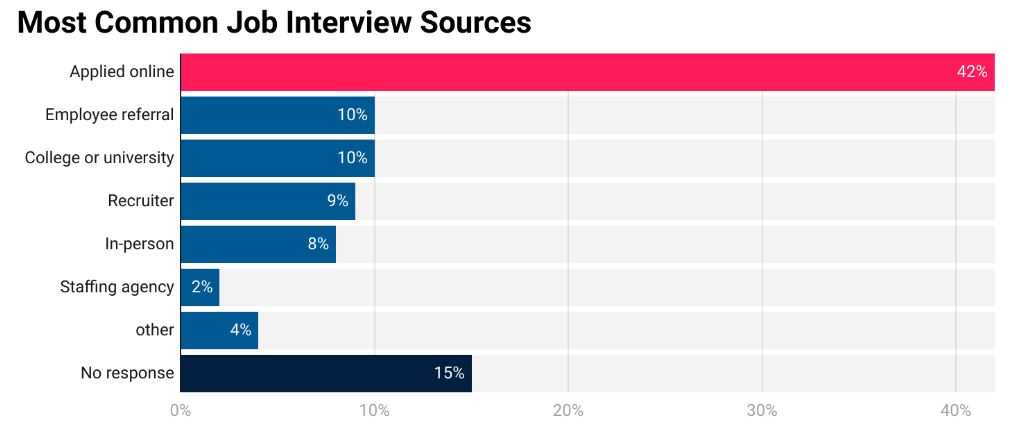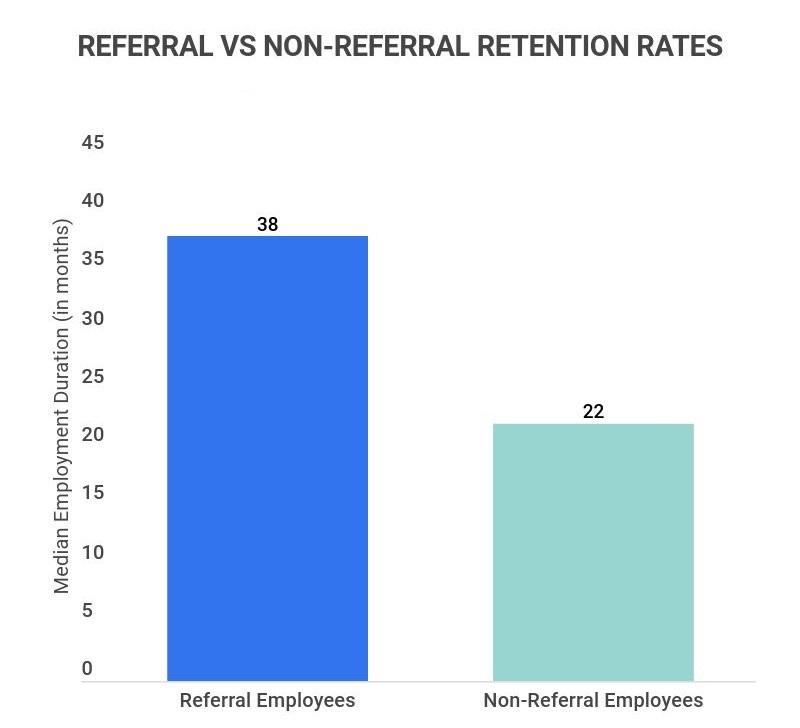Key Takeaways
- Companies can save enormous amounts of money if they switch to a referral-based recruiting system.
- Designing an employee referral recruitment program can go a long way in realizing a firm’s recruitment goals.
- Employees hired through referral schemes stay longer than those from other sources.
The world economy is growing at an unprecedented pace, fueled by the massive boom of small businesses globally. Big or small, companies that witness growth must do everything in their capacity to sustain this growth for an extended period. However, they’re faced with countless challenges, and recruiting might be the most crucial one.
It is widely accepted that having an effective hiring strategy and maintaining a robust pipeline of talented professionals is vital for sustained growth. Referral recruiting has emerged as a highly beneficial methodology that has helped HR managers in their hiring goals while reducing overall costs.
A study conducted by Linkedin pointed out that a company can save up to $7,500 in sourcing and recruiting costs by choosing referral recruiting. Many other surveys have suggested similar findings that a well-designed employee referral recruitment program has numerous benefits. The below infographic shows referral recruiting remains the second most preferred source for interviewing candidates.

Source: Enterprise Apps Today
Designing an Effective Employee Referral Recruiting Program
Step 1. Understanding Your Hiring Needs
The first step while creating an efficient employee referral recruitment program is to understand the hiring needs of your organization. The HR department must work closely with other departments like finance, operations, and data analytics to ascertain the company’s growth prospects and how many resources are needed. This is necessary to map out the existing and projected human capital requirements for the foreseeable future.
After deciding the company’s hiring needs, the next step is to allocate the same in different categories. For instance, HR managers must decide what percentage of potential employees they want to hire from referrals. Most corporations make a balance between referral recruiting and hires from other sources like online applications.
Many reports have shown that employees hired through referral recruiting stay for longer durations than those that came from other sources. The below infographic shows that referred employees have a retention rate of nearly 40 percent.

Source: Zippia
Step 2. Set and Communicate Rules and Regulations
After you’ve decided how many employees you want to hire via referral recruiting, your next step is to plan the various rules and regulations of the program. Your employee referral program must be honest, fair, consistent, and unambiguous if you want it to be successful and productive.
Establish clear ground rules at the outset so that everyone involved is aware of what to anticipate, and then make sure you uphold them. Establishing an official employee referral program policy that compiles all the rules in one place is a smart idea. These details and rules should explain the basic working of the program and the rewards employees receive after referring a person.
Next, your priority should be to communicate these details to the workforce of your organization. You can do this by circulating an email, text messaging, or simply putting it on the company bulletin board.
You should Include pertinent information, such as the job title of your upcoming hiring, the team they’ll be working with, their primary responsibilities, and the qualifications they must meet.
Step 3. Launch and Promote Your Campaign
Setting up an official launch is a terrific approach to presenting an employee referral program to your firm. You can either plan a special event or ask a high-ranking official to make the announcement. This strategy works best for firms going through a hypergrowth phase HR managers should develop targeted campaigns to promote the employee referral recruiting program.
Your marketing initiatives should encourage your staff to participate in your employee referral program. Many companies try unique strategies like having healthy competition between different teams and giving additional rewards to the winners.
Step 4. Keep It Updated By Adding New Ideas and Rewards
The Human Resources department needs to be creative while designing an effective employee referral recruiting program. The most efficient practices to design a referral recruiting program keep on changing as corporations try more innovative ways to get the most talented individuals. Hence, HR managers should also focus on ensuring that their referral programs are up-to-date and satisfactory as per the current standards.
Recognizing and expressing your appreciation for your employees’ efforts is the most crucial thing you can do. Make sure they are aware of the value of their contribution to your business. The ideal scenario is to have the top management of your company publicly and personally thank them.
To keep your staff motivated and involved, regularly offer new elements to your employee referral program. Gamifying your employee referral process is a terrific approach to keeping your staff engaged and enthusiastic.
Bonuses for employee referrals don’t have to be excessive. Employees can be easily motivated by giving them small, inexpensive rewards like gift cards, event tickets, or extra vacation days.
Step 5. Evaluate The Referral Recruiting Program and Make Adjustments
Many budding enterprises make the mistake of ignoring this final step, which is arguably the most vital. As mentioned earlier, referral recruiting is a dynamic and ongoing process with a lot of moving parts. An important function of the HR department is to ascertain the effectiveness of their employee referral recruiting program.
Some aspects of your referral process might work better than others while some could be causing bottlenecks. It is the HR department’s job to pinpoint these inefficiencies and rectify them. The HR professionals have to look at a few key metrics to make the evaluation process more streamlined.
The number of total referrals vs. the number of hired referrals, the number of referrals per role/department, participation rate, and referral-to-hire ratio are some of the most important metrics that you should track to evaluate your employee referral program.
Benefits of a Well Designed Employee Referral Program
More and more companies are going with employee referral recruiting programs as it has many well-known benefits. These are:
- Reduced Costs
Employee referrals are cost-effective and cheaper than other recruiting methods as companies don’t need to spend on advertising and job postings. Many other expenses are eliminated if the hiring managers design an effective employee referral recruiting program.
- Better Culture Fit
Your current employees are more likely to bring candidates that fit your company’s culture and profile. Hence, employee referral recruiting programs are a better alternative when your goal is to find candidates who are a better fit for your corporate culture and environment.
- Swift Processing
A Glassdoor report shows that applicants from employee referral programs are 2.6-6.6 percent more likely to accept a job offer. As a result, the recruitment process through referrals is much faster and leads to better results. The HR department doesn’t have to spend much time sifting through hundreds of irrelevant applications.
Contact BenchPoint, a healthtech recruitment firm, if you’re interested in learning more about the employee referral recruiting program. We’ll demonstrate how to keep a continuous hiring pipeline so that qualified applicants are always just a click away.
We are here to answer any questions you may have and will work with you to create hiring strategies that are more efficient and streamlined.
